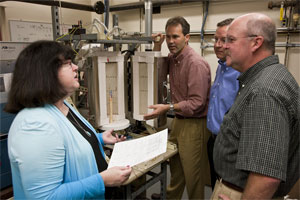The Fuel Cell Generation
Irvine, Calif., April 2009 -- In 1839, Welsh physics professor Sir William Grove had a bright idea. He knew that water could be split into hydrogen and oxygen by sending an electric current through it, but he wondered: if the process were reversed, could hydrogen and oxygen produce electricity and water?
Grove proved that it could, and from his experiments, the fuel cell was born. Scientists continue to look to the electrochemical conversion devices, which leave only heat and water as byproducts, for quiet, efficient and pollution-free power generation. Today, there are at least six different types of fuel cells that power everything from large generating plants and NASA rockets to cars and small portable communication devices.
|
UCI researchers affiliated with the National Fuel Cell Research Center (NFCRC) and Calit2 are finding ways to improve both the devices’ efficiency and their incorporation into other systems – hybrid technologies, distributed-generation operations and the smart grid of the future.
Improving Efficiency
Material scientists Daniel Mumm and Martha Mecartney are making changes in the fundamental materials in one of the most promising technologies, the solid oxide fuel cell (SOFC), to improve its commercial viability.
The SOFC is comprised of four layers, three of which are ceramics. A single cell consisting of these four layers stacked together is typically only a few millimeters thick; from 30 to a couple hundred cells are connected to form a fuel cell stack.Air is pumped into the device’s cathode, where an electrocatalytic reaction changes it from oxygen molecules into negatively charged oxygen ions. These ions then travel through an ion-transport membrane called an electrolyte. The electrolyte, made of a dense ceramic material, passes them to the anode, where they oxidize hydrogen fuel.
This chemical reaction produces water and two additional electrons that pass between the anode and the cathode via an external circuit, creating electricity. As long as there is a constant flow of hydrogen and oxygen into the cell, electricity will flow out.
The ceramic materials used in the cells present researchers with a quandary. Because they are more effective at higher temperatures, solid oxide fuel cells traditionally have been designed to operate at 1,000 degrees Celsius.
“The higher you go in temperature, the faster your reactions occur,” Mecartney says. “But when we go to lower and lower temperatures to preserve and stabilize the materials, these reactions get slower.”
She focuses on finding ways to change the fuel cell’s electrolyte, so ions can be transported more quickly at lower temperatures, while Mumm seeks to develop anode and cathode materials that can maximize reaction speed when the operating temperature is reduced.
The electrolyte is an immensely resistive part of the system, Mecartney says, so she uses several approaches to make it more efficient.
“We do anything we can to move those ions, whether it’s creating higher flux (more ions moving per unit of time) or making it easier for them to move by increasing conductivity.”
Mumm is working on composites that go far beyond the materials currently in use. He also uses coatings to engineer better surfaces on the interconnect layers, and he studies degradation at the interfaces.“We’re looking for materials that work better or ways to change what we’re already using,” he says. “If we can bring the temperature of a fuel cell down to 800 degrees, that is a huge move forward.”
System Integration Challenges
Their unique properties make fuel cells the perfect complement to other powergeneration devices and systems. Jack Brouwer, a thermal systems scientist, is investigating ways to integrate them into distributed-generation systems, hybrid technologies like gas turbine/fuel cell systems, the existing electrical grid and even the smart grid of the future.
Building economical systems around fuel cell materials can be daunting. Ceramics, for example, are used in the stack connectors because they can withstand the high temperatures required to run the cell efficiently. But the system would become less expensive
if it incorporated metal connectors, which are cheaper to manufacture but cannot withstand intense heat.
Perhaps his biggest challenge, though, is developing technologies for advancing fuel cell systems into “load-following” operations so they are dynamic enough to interact with other systems. Renewable energy sources like wind and solar can be sporadic, Brouwer says, resulting in grid instability. Fuel cell systems potentially could respond to intermittent delivery issues by increasing their own production and sending the power where it’s needed.
“This idea of ‘dispatchable generation’ is very important for complementing renewable power,” says Brouwer. “Five years ago, scientistsnever thought solid oxide fuel cells could follow loads dynamically. Then we started to prove that the physics of the fuel cell can respond very rapidly.”
First iterations of the technology will be computer-controlled by people, but Brouwer envisions “smart systems” that can respond autonomously. The systems will have the intelligence to process ongoing information from independent operators and the main grid, decide on the best response and react immediately. “This is going to be very important for the smart grid of the future.”
Hybrid technologies, including fuel cell/gas turbine systems, also have lots of potential in sustainable energy systems. Because of the way the two technologies interact, integrating them actually produces higher efficiency in the fuel cell than using it alone.
Other benefits: emissions are reduced because the fuel cell replaces burning fuel between the compressor and the turbine; and the fuel cell’s heat loss can be used to produce extra electricity. “Not only do we get more power out of the fuel cell, but it also produces it at higher efficiency,” says Brouwer.
The NFCRC, which is part of UCI’s Advanced Power and Energy Program, is at the forefront of this innovative technology. In collaboration with Southern California Edison and engineering firm Siemens, they built and tested the first proof-of-concept prototype. The hybrid systems could be available commercially within a couple of years.
“This technology can be used in any application,” Brouwer says, “from the central plants of the future down to the neighborhood level.”

